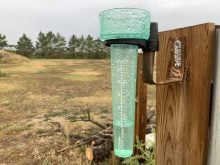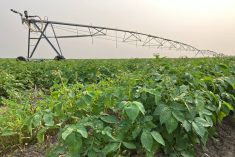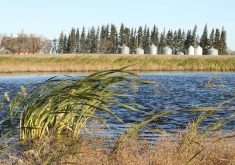By early July, Richard Stamp already knew he wouldn’t be harvesting his dryland acres this year.
“Last year, we had a relatively good crop — double what we would expect on it — but this year, we will not be combining it,” said the Enchant-area pedigreed seed grower.
“It’s definitely a big difference this year, that’s for sure.”
Hot, dry conditions — especially in southern Alberta — devastated dryland crops. But for irrigation producers, the blistering heat only reinforced how critical an $815-million irrigation expansion is for their operations and the province.
Read Also

Canola’s clubroot success story
At one time, scientists, agronomists and growers were extremely worried clubroot would spread across the Prairies and devastate Canada’s canola industry.
“Irrigation offers some stability in our crop production,” said Stamp, who irrigates in the Bow River Irrigation District and the Eastern Irrigation District.
The project will not only add 200,000 irrigated acres, but bring stability to the entire system, he added.
“It’s like having good highways and power systems — by investing in all of these, you’re just giving everyone better infrastructure.
And the benefits aren’t only for those with irrigated land, said Stamp.
“That investment I believe has even more impact past the farm gate than it does on the farm. Yes, there are farms that will be able to get more acres irrigated, but really, it’s about the big-picture security of our water.”
Modernizing the system is a key objective, said David Westwood, general manager of the St. Mary River Irrigation District.
“We’ll be able to convey water in a much more efficient manner and will therefore be using less water than we have in the past,” said Westwood, adding districts may be able to offer producers expanded irrigation acres once the projects are done.
“Every district is a little bit different, but the majority do not have any more acres we can offer. We are completely subscribed. So the end goal is ultimately that we could offer expansion irrigation acres.”
Reservoirs and pipelines
The $815-million expansion was widely hailed as “historic” when it was announced last fall, and this year’s drought and heat have underscored that description. Eight irrigation districts are participating, putting up $163 million and taking on a $407.5-million loan from the Canadian Infrastructure Bank (a Crown agency lending the money at one per cent interest). The provincial government is putting in the remaining $244.5 million. Along with building four new off-stream reservoirs, there will be 56 modernization projects, much of that converting open canals to underground pipelines.
“Ultimately, all these projects will either save water or make additional water available, and they will be completed years sooner than they would otherwise be completed,” said Richard Phillips, general manager of Bow River Irrigation District, which will spend just over $100 million.
“It should enable further expansion of our district,” said Phillips. “Our district has expanded more than any other irrigation district has, going from 211,000 to 295,000 acres. It’s projected that these projects could enable expansion up to an additional 25,000 acres in the district.”

Three-fifths of that money will be spent on a new reservoir with a capacity of roughly 20,000 acre-feet (24 million cubic metres).
“It’s not a huge reservoir compared to the amount of storage we already have available in our district, but it will make more water available and it will save water,” he said.
The new reservoir will be on the main canal between two existing ones, allowing the district to both store additional water and to re-regulate the flow of the canal at that midpoint, which currently isn’t possible.
“That leads to waste at the bottom end of the system too frequently.”
Most of the remaining $40 million will be spent on installing pipelines to replace canals, which not only lose water to evaporation but also leak — losses that are especially painful in a year like this one.
“The water savings are significant, and for those producers that are still irrigating off of the open canal systems, it will improve the reliability of their water supply,” said Phillips.
But adding acres is also a priority, he added.
“Certainly that’s one of the government’s main interests in this,” he said. “They’ve made that very clear, and we expect that the projects in our district will result in water savings that will enable quite a bit more land to be irrigated within our district.”
Districts eye merger
The St. Mary River Irrigation District will also be expanding its reservoir capacity and replacing canals with pipelines — but first, its members will need to vote on a merger between the district and the Taber Irrigation District, which both draw from the same source waters.
“It just makes a lot of sense for us to be one district operating as one organization,” said Westwood, adding the expansion was the catalyst for those discussions.
“Right now, we have some irrigators that are customers of both districts, and we recognize if those borders were removed and we were one combined district, irrigators would find it a lot easier to deal with only one entity.”
The boards for both districts approved the merger in principle in June and will take it to a membership vote following open houses in the coming months.
“The initial feedback we’re receiving on the initial grassroots level is that irrigators are in favour of it in both districts, but we want to have an open house where we can do some education,” he said.
Financially, the two organizations are already “very much aligned,” with similar water rates and administrative functions. A merger would simply improve efficiency, he said.
“I think that will end up benefiting the irrigator in the end,” said Westwood. “We both do things well and we can both learn from each other, so we’ll be able to take the best of both worlds and roll that into one new organization.
“I really think it will give the irrigators more options and more freedom to be able to design potential expansion, if that’s what they’re interested in.”
As a result, Westwood expects to see “great economic spinoff” for the region once the infrastructure is completed.
“Every $1 that’s invested in irrigation infrastructure leads to a $3 GDP return on investment,” he said. “It’s a real opportunity for the province to showcase what we do really well and become a world player when it comes to food production.”
An economic driver
Phillips agrees.
“Irrigated land is simply far more productive than dryland, with far more crop choices available, and they tend to be higher-value crops that have more of the spinoff economic benefits associated with processing,” he said.
“It’s much more economically intensive to grow crops that are produced here, like potatoes or sugar beets, as compared to simply putting wheat on the rails and sending it to the ports.
“That’s good — that’s an important part of agriculture — but it doesn’t have the same economic spinoff as processing things here in Alberta.”
That’s ultimately why irrigation farmers are willing to fund the bulk of these projects, he added.
“The irrigation farmers, through the irrigation districts, are ultimately funding the bulk of it because it’s good for them,” said Phillips.
“The Canada Infrastructure Bank is providing a very attractive long-term low-interest loan. But it is a loan, not a grant, that will be repaid in full by the irrigation districts, with the (provincial) government, of course, providing a nice 30 per cent grant as part of this project.”
“At the end of the day, the majority of these projects are going to be borne financially by the actual irrigator, but they’re willing to do that because it leads to opportunity,” Westwood added.
“Irrigated farms don’t need significant land bases to be successful and to be able to provide a living. They can grow high-value, high-quality crops with a good yield.”
And for Stamp, that’s the most important thing about this investment into irrigation expansion.
“I think the industry will benefit from the confidence that irrigated agricultural production provides to everyone who wants to set up shop here,” he said. “It gives confidence that we’re not just here for today — we’re here for the coming generations going forward.”















